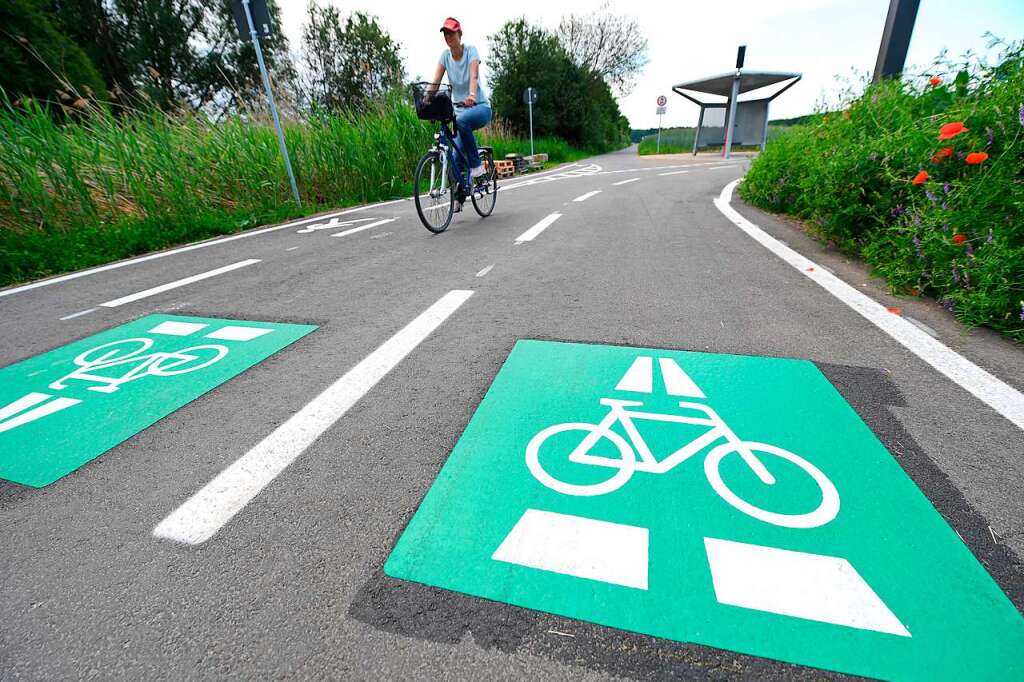Cycle superhighways should enable rapid and as uncomplicated progress as possible. This should also lure commuters with longer trips on their bikes. The first connection will not be completed before 2028.
A continuous high-speed network for cyclists in the Rhine plain between Müllheim and Bühl with cross-roads towards the Rhine and the Black Forest: This project should make the everyday life of commuters in southern Baden much more comfortable in the medium term. The project is currently in the planning phase. “It will also help the city of Freiburg to solve its traffic problem,” says Fabian Kern from the Verkehrsclub Deutschland (VCD) already happily. In the course of public participation, however, there are already differences of opinion regarding the routing.
The feasibility study has passed through a first route
“Around 900 tips have been received from the citizens,” says Martin Laufer, who is responsible for the regional council (RP) Freiburg as the project manager for the cycle expressways to Emmendingen and Waldkirch, which are initially planned as the “Y” due to their shape. These connections have passed the feasibility study, they have a potential of (far) more than 2500 users, the RP has taken over the construction responsibility for them and is therefore responsible for the planning, construction and maintenance of the cycle superhighways.
A point at which the route from the surrounding area is to flow into the Freiburg city area (the crossing Höhenweg / Wildtalstraße) has been identified; within Freiburg, the city is responsible for the route. “We are currently considering whether we are planning in Freiburg with a strong axis or with several axes,” says Freiburg’s Mayor Martin Haag. There is also a “trunk” of the line that continues to the north outside Freiburg and is supposed to cross Gundelfingen along the railway line.
What follows is open. Martin Laufer shows on the homepage set up by the RP (http://www.breisgau-y.de that there are two main variants for the connection to Emmendingen and three main variants for the route to Waldkirch. Plus various possible alternative sections of the route and suggestions from citizens, which are still to be checked and which are reflected in the plans as a multitude of colorful, sometimes intersecting lines.
What is important in a cycle expressway?
What is important, what makes the decision to say yes to a route? “We have a set of criteria,” says Laufer. On the one hand, there is the quality of use for the cyclist, which includes directness, safety and health impairments (for example in the case of a route that runs along a federal road). A necessary intervention in traffic use, for example in local public transport or forest traffic, has a negative impact, after all, the feasibility (must space be purchased, are conversions due?) Is assessed.
Finding a solution is likely to be quite tricky, especially in the Freiburg urban area, with up to 12,000 predicted daily speedway users and at the same time dense development and an already strained network of roads. “There will be conflicting goals,” says Martin Haag under no illusions. “We need space, it can cost parking spaces and the width of the street, and car traffic could lose priority at intersections.”
In the end, it should be weighed up and invested heavily in order to give cyclists advantages by setting up induction loops to activate traffic lights, a new roundabout or a bridge. Around 30 million euros in state and federal funds are budgeted for the Y alone. It should be ready by 2028. That sounds far away.
“We practically have to build 26 kilometers of state roads, which is a very ambitious schedule compared to other measures,” says Laufer, defending the procedure. The feasibility study is followed by draft planning, approval planning, building law procedures, planning approval, building law and implementation planning; the construction itself is expected to take up to two years. “But we will see that we can complete individual sections earlier. And with every singular measure such as a roundabout, progress is made in advance for bicycle traffic.”
The feasibility of further cycle superhighways is to be examined in 2021
In the state sponsorship and controlled as a project by the Ortenaukreis, there is a cycle superhighway from Offenburg to Strasbourg, and also one from Offenburg to Gengenbach is sponsored by the Ortenaukreis. The feasibility studies of the Regional Association of the Southern Upper Rhine (RSO) for five further high-speed cycle routes are to be completed in the course of 2021, for the routes Freiburg – Müllheim, Freiburg – Breisach, Freiburg – Kirchzarten, Emmendingen – Lahr and Offenburg – Bühl. “All in all, it is a cycle expressway network that covers 220 kilometers,” says Jens Fiedler from the RSO.
Baden-Württemberg is also one of the pioneers nationwide, with 16 cycle superhighways across the country, for which a building contractor has been established. The planned routes are mainly in the Rhine valley as well as in the greater Stuttgart, Tübingen and Heilbronn areas and on Lake Constance.
In the context of public participation, the RP was repeatedly exposed to reservations and fears about the project. “Especially future residents were often frightened by the word ‘Radschnellweg’ alone”, is Martin Laufer’s experience. “That’s why we shot a video – deliberately at a location in Freiburg that has the maximum expected load with a daily load of 12,000 cyclists,” explains Laufer.
This video put a lot of fears into perspective because it illustrates how this cycle traffic is ultimately distributed over the day and remains manageable. In addition, citizens and local politicians sometimes worry that a tree will be felled, sometimes that a piece of land will be cut. Or it is feared that priority switching for cyclists will keep the already excessive car traffic in a town for longer.
Cycle superhighways should relieve the city
For the VCD managing director Fabian Kern, the concerns are sometimes unrealistic. For example, when citizens worry about whether they can still get out of their driveway if cyclists speed by. Or warn of a cycle expressway near the kindergarten, where today various thoroughfares without speed restrictions already lead past kindergartens. “But a cyclist can only travel at 25 kilometers an hour.” In addition to relieving the city of Freiburg in particular, Kern believes that the cycle high-speed network could also make climate-damaging road constructions such as the further construction of the B-31 West superfluous.
Martin Haag also attaches great importance to emphasizing the great importance that the cycle superhighways have for him: “In Freiburg, especially from the north, we have some of the highest commuter flows. Cyclists are quiet, require little space, do not emit any emissions. For me this is a central project for the region in terms of climate protection and traffic, an incredibly important measure for Freiburg. “
Supra-local cycle superhighways are intended to offer commuters in particular the opportunity to move forward safely, safely and quickly. Thus, they should offer the chance to get to work by bike, pedelec or e-bike even if they have to travel further, according to the Southern Upper Rhine Regional Association, which has only carried out a potential analysis and is currently preparing feasibility studies for high-speed cycle paths in southern Baden. Cyclists from the fields of tourism, leisure and sport are also considered.
The cycle superhighways should largely be laid out in such a way that one can drive in a straight line and separate from car and foot traffic. Cycle superhighways should score not through high top speed, but rather through a high average speed.
Various cycle expressways are also being planned in southern Baden (see graphic). First of all, the connections from Freiburg to Emmendingen and Waldkirch should be completed by 2028. The minimum number of users of 2500 drivers is a prerequisite for full state and federal funding. In one-way traffic, at least 80 percent of the paths should have a width of at least three meters, in two-way traffic of at least four meters. When used jointly with agricultural or pedestrian traffic, the width is five, with high pedestrian traffic 6.5 meters.
–
–


